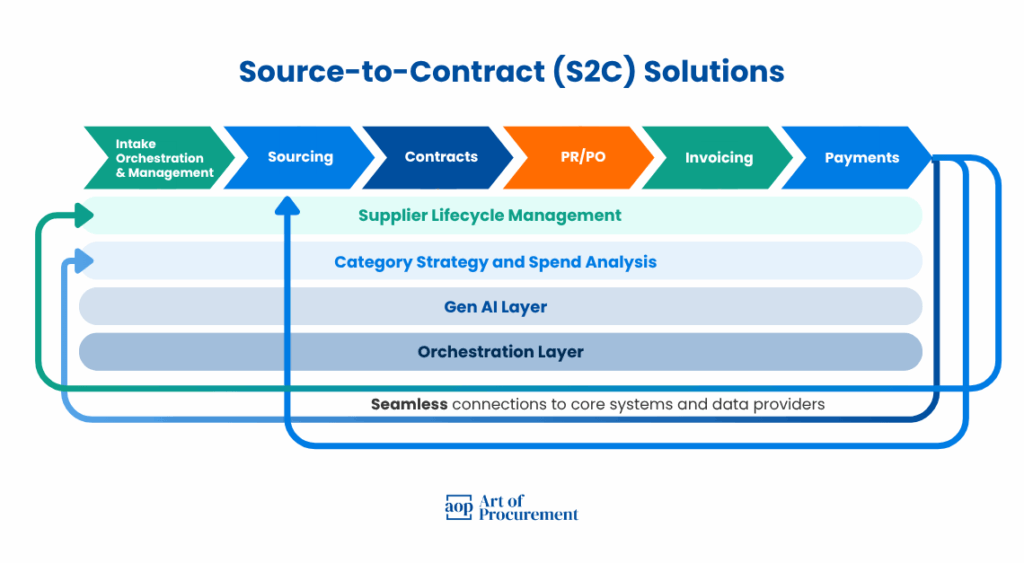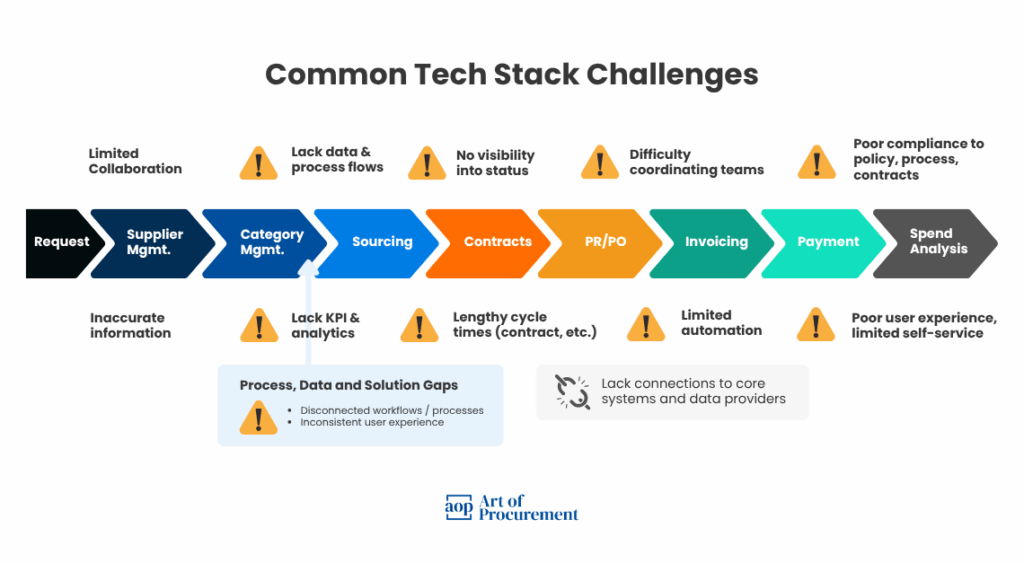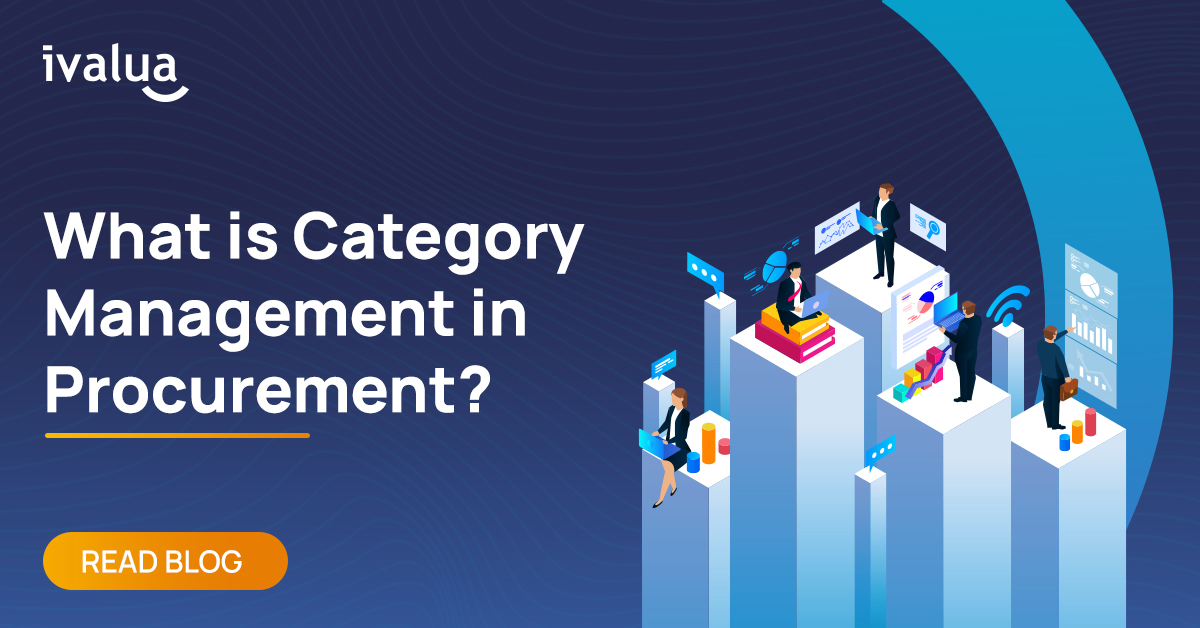Organizations today operate in an environment that demands agility, precision, and forward-thinking strategies to stay ahead of the competition. For Chief Procurement Officers (CPOs) and their teams, selecting the right Source-to-Contract (S2C) solution is an essential step toward strategic procurement transformation. This decision shapes the efficiency of procurement operations, impacts stakeholder perceptions, and creates measurable business value.
If you’re navigating this complex process, The Source-to-Contract Technology Buyer’s Guide is tailored to help you make informed decisions, implement solutions effectively, and unlock the full potential of S2C technology.
Key Takeaways
- S2C platforms optimize procurement efficiency, reduce costs and risk, streamline supplier relationships, and improve contract compliance with automation and real-time data visibility.
- The right S2C platform empowers organizations to modernize procurement operations, achieve strategic goals, and stay adaptable to future challenges.
- Ensure thorough evaluation and planning to maximize ROI and secure long-term success.
What is Source-to-Contract?
Source-to-Contract (S2C) refers to the initial stages of the overarching Source-to-Pay (S2P) process. While S2P encompasses procurement’s full lifecycle, S2C focuses on strategic sourcing, supplier management, contract lifecycle management, and related processes.
Using S2C platforms, organizations can improve savings, reduce risk, enhance procurement efficiency, streamline supplier relationships, and improve contract compliance through automation and real-time data visibility. These tools allow seamless collaboration between procurement teams and stakeholders and help secure competitive advantages in sourcing and supplier management.
Why S2C Transformation Is a Strategic Priority
The procurement solution you choose significantly affects how efficiently your team can secure value and implement strategies. CPOs using the right toolset can ensure compliance, improve cost savings, mitigate risks, and enhance stakeholder satisfaction.
Conversely, ill-suited solutions may create inefficiencies and risk eroding procurement’s ability to influence and impact business strategy and outcomes.
Key goals accomplished with the right S2C solution include:
- Generating significant cost savings through better spend management.
- Streamlining processes using automation, resulting in enhanced productivity.
- Proactively mitigating supplier and business risks through improved visibility.
- Better outcomes and stronger stakeholder relationships through actionable, data-driven insights.
Key Features of an Effective S2C Platform
When deciding on an S2C solution, certain non-negotiable features should be at the top of your checklist. Here’s what to prioritize:
- Automation: Eliminate repetitive and manual tasks across the sourcing and contracting process.
- Data Analytics and Reporting: Leverage insightful reporting tools that identify trends and opportunities for cost savings.
- Supplier Management: Maintain a centralized view of supplier risk and performance metrics to mitigate issues and streamline onboarding.
- Contract Lifecycle Management: Automate contract renewal management and ensure alignment with sourcing strategies.
- Integration: Ensure compatibility and seamless integration with P2P systems, ERP software, and PLMs.
Choosing a platform that offers a combination of these capabilities sets the foundation for procurement success while ensuring scalability as your organizational needs evolve.
Watch our Source-to-Contract (S2C) On-Demand Demo.

Benefits of a Strategic S2C Transformation
Investing in an advanced S2C platform isn’t just about modernizing processes; it’s about enabling lasting organizational transformation. Here are the benefits your procurement team should expect from a well-implemented S2C strategy:
1. Enhanced Cost Management
S2C solutions allow procurement teams to aggregate spend data, negotiate better deals, and minimize overspending. According to Ardent Partners, every additional dollar brought under procurement’s control can yield savings of 6-12 percent.
2. Time Savings Through Automation
Manual contract management and supplier onboarding are tasks that drain precious team resources. Automation tackles these inefficiencies, creating bandwidth for high-value projects.
3. Better Risk Mitigation
Approximately 98% of organizations struggle to achieve visibility beyond tier-one suppliers. S2C platforms centralize supplier data, giving procurement teams the tools to identify risks before they affect operations.
4. Improved Collaboration
S2C platforms improve internal collaboration by connecting cross-functional teams with real-time procurement insights. They also foster stronger external relationships, aligning supplier expectations with organizational goals.
5. Stakeholder Empowerment
Sophisticated data analytics empower CPOs and their teams to demonstrate measurable business impact to stakeholders. Clear reports and performance dashboards help elevate procurement as a strategic function.
Six Steps to Choosing the Perfect S2C Solution
Choosing the right S2C solution is as much about aligning technology with business needs as it is about ensuring stakeholder buy-in. Use this step-by-step approach to make the best decision:
Step 1. Assess Current Needs
Take an honest look at your existing procurement processes, team capabilities, and technology stack. Identify inefficiencies, bottlenecks, and existing gaps in functionality.
Step 2. Define Your Goals
What does success look like for your procurement function? For some, the goal may be risk mitigation. For others, it could mean shaving weeks off procurement cycle time or gaining visibility into tail spend. Make sure your objectives are clear and measurable.
Step 3. Evaluate Core Features
Ensure the platforms you’re evaluating align with your operational needs:
- Can they integrate easily into your existing ecosystem?
- Are workflows customizable to fit your unique requirements?
- Do analytics enable smarter, data-backed decision-making?
- Does the solution include capabilities to support spend and use cases in scope now and in the future?
Step 4. Prioritize User Experience
Procurement’s ability to deliver value relies on the adoption of the tools it implements. Prioritize solutions with a user-friendly interface that both internal and external stakeholders will find easy to use. Also, it is important to plan for and invest in change management.
Step 5. Consider Implementation Readiness
Evaluate your organization’s readiness for change. Do you have the necessary infrastructure, budget, and key stakeholder buy-in? Consider whether a phased rollout or big-bang implementation approach makes more sense for your team.
Step 6. Analyze AI Capabilities
AI is no longer a luxury in procurement technologies; it’s a necessity. AI-powered analytics, sourcing and contracting capabilities help procurement leaders uncover value in ways that manual strategies cannot.
Create a holistic and seamless approach to S2C, download our Source-to-Contract (S2C) Datasheet.
Potential Challenges in S2C Implementation
Transforming your procurement function through S2C technology isn’t without its pitfalls. Being aware of common issues will help you avoid them:
- Poor Data Quality: Ensure your data is clean, updated, and consistent across systems before integration.
- Underestimating Scalability: Solutions should support your organization’s growth trajectory. Avoid platforms that limit extensibility and expandability.
- Neglecting Change Management: Get buy-in early and implement robust training programs to ensure adoption.
- Creating a Complex Technology Stack: Ensure solutions involved in a process will seamlessly move data, and have a consistent user interface and user experience.
Proactively addressing these challenges will ensure your transition to S2C technology is smooth and delivers ROI quickly.

Final Thoughts
Digital transformation in procurement begins with choosing the right source-to-contract solution. A well-chosen S2C platform doesn’t just optimize your current processes; it empowers your organization to adapt to future challenges with agility and resilience.
Remember, the success of your procurement function hinges not only on the platform you choose but also on how well it is implemented and embraced by your team. Take the first step toward modernizing your procurement workflows today.
Looking for an S2C solution designed to meet the demands of your organization? Contact us to explore how our platform combines innovation, user-friendly features, and cutting-edge AI to create lasting procurement success.
Download The Source-to-Contract Technology Buyer’s Guide
FAQ’s on the S2C Guide
What is Source-to-Contract (S2C)?
Source-to-contract (S2C) covers the strategic stages of procurement, including supplier selection, sourcing processes, and contract lifecycle management. It helps organizations streamline workflows, enhance supplier relationships, and improve compliance through automation and real-time data insights.
Why is selecting the right S2C solution important?
Choosing the right S2C solution is critical to ensuring procurement efficiency, mitigating supplier and business risks, and improving cost savings. The right platform enables automation, data-driven decision-making, and seamless collaboration with stakeholders, empowering procurement teams to achieve measurable business value.
How can an S2C platform benefit my organization?
Here are some key benefits of implementing an S2C solution:
- Generate cost savings through better spend management.
- Save time by automating manual processes.
- Mitigate risks by providing full supplier visibility.
- Improve collaboration across teams and with suppliers.
- Empower stakeholders with insightful data and performance reports.




